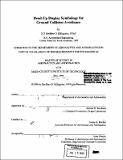| dc.contributor.advisor | Steven W. Jacobson. | en_US |
| dc.contributor.author | Billingsley, Geoffrey O. (Geoffrey Owen), 1975- | en_US |
| dc.contributor.other | Massachusetts Institute of Technology. Dept. of Aeronautics and Astronautics. | en_US |
| dc.date.accessioned | 2009-12-10T19:16:06Z | |
| dc.date.available | 2009-12-10T19:16:06Z | |
| dc.date.copyright | 1999 | en_US |
| dc.date.issued | 1999 | en_US |
| dc.identifier.uri | http://hdl.handle.net/1721.1/50125 | |
| dc.description | Thesis (S.M.)--Massachusetts Institute of Technology, Dept. of Aeronautics and Astronautics, 1999. | en_US |
| dc.description | Includes bibliographical references (p. 109-111). | en_US |
| dc.description.abstract | Four predictive ground collision avoidance displays (Break-X, Chevrons, Mountain, and Highway) were tested using a fixed-base T-38 simulator with a projection screen and simulated Head-Up Display (HUD). The Break-X was similar to the conventional military alert except that it remained on the screen until the aircraft was recovered to safety. The Chevron display consisted of two caret symbols (> <) which slid horizontally inward as danger increased, forming an X identical to the break-X. The Mountain display used a single icon which moved upward in the HUD as danger increased, mimicking the motion of the terrain outside. The Highway was a preview display, which consisted of a perspective elevated surface shown at the desired altitude. Twelve subjects flew through a series of Predictive Ground Collision Avoidance System (PGCAS) situations in zero visibility using each display. For about 30 seconds after the alert, they attempted to maintain a set altitude above ground, clear of the terrain but below ground radar threats. Performance metrics were rolling tendency, altitude maintenance, pilot effort, and subjective preference. The Break-X performed more poorly than the other displays in every category. It attracted attention but proved to be impractical for the terrain-following/terrain-avoidance task. Pilots were able to spend only 40% of the flight time between the desired altitudes when given the Break-X, and on average, they crashed every 5 runs. The Chevrons were more useful, although their horizontal motion did not correspond to the outside world. The Chevrons and Mountain averaged only one crash in 12 runs. The vertically moving Mountain had physical analogue, so pilots found it more natural to follow. This enabled them to spend approximately 80% of the time between the altitude limits, while the Chevrons allowed 70%. The better altitude performance from the Mountain came at the cost of higher effort levels, as shown by a significant difference in RMS longitudinal stick movement. However, a false illusion of wings-level produced slightly poorer roll performance from the Mountain. Pilots crashed the least using the Highway, averaging about one crash per 50 runs. It enabled them to fly approximately 90% of the time within the desired altitude layer. The Highway produced the highest objective and subjective ranking, and its predictive nature made it the best display for the task investigated. | en_US |
| dc.description.statementofresponsibility | by Geoffrey O. Billingsley. | en_US |
| dc.format.extent | 111 p. | en_US |
| dc.language.iso | eng | en_US |
| dc.publisher | Massachusetts Institute of Technology | en_US |
| dc.rights | M.I.T. theses are protected by
copyright. They may be viewed from this source for any purpose, but
reproduction or distribution in any format is prohibited without written
permission. See provided URL for inquiries about permission. | en_US |
| dc.rights.uri | http://dspace.mit.edu/handle/1721.1/7582 | en_US |
| dc.subject | Aeronautics and Astronautics. | en_US |
| dc.title | Head-up display symbology for ground collision avoidance | en_US |
| dc.type | Thesis | en_US |
| dc.description.degree | S.M. | en_US |
| dc.contributor.department | Massachusetts Institute of Technology. Department of Aeronautics and Astronautics | |
| dc.identifier.oclc | 48196921 | en_US |
